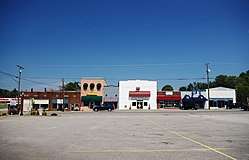Ardmore, Tennessee
Ardmore is a city in Giles and Lincoln counties, Tennessee. The population was 1,213 at the 2010 census.[5] Ardmore is the site of a Tennessee Department of Tourist Development Welcome Center. It borders its sister city, Ardmore, Alabama.
Ardmore, Tennessee | |
|---|---|
 Buildings along Main Street (SR 7) | |
 Location in Giles County,Tennessee. | |
 Ardmore, Tennessee Location in Giles County,Tennessee. | |
| Coordinates: 35°0′17″N 86°51′5″W | |
| Country | United States |
| State | Tennessee |
| Counties | Giles, Lincoln |
| Founding | 1911 |
| Government | |
| • Mayor | Tim McConnell |
| Area | |
| • Total | 4.71 sq mi (12.19 km2) |
| • Land | 4.70 sq mi (12.17 km2) |
| • Water | 0.01 sq mi (0.02 km2) |
| Elevation | 886 ft (270 m) |
| Population (2010) | |
| • Total | 1,213 |
| • Estimate (2019)[2] | 1,221 |
| • Density | 259.90/sq mi (100.35/km2) |
| Time zone | UTC-6 (Central (CST)) |
| • Summer (DST) | UTC-5 (CDT) |
| ZIP code | 38449 |
| Area code(s) | 931 |
| FIPS code | 47-01640[3] |
| GNIS feature ID | 1304866[4] |
| Website | www |
History
Ardmore began in 1911 as a railroad stop named "Austin" after a store owner, Alex Austin, who served construction crews working on the nearby L&N Railroad (now CSX) line that would connect Nashville, Tennessee, and Decatur, Alabama. When the L&N opened a depot in 1914, it changed the town's name to "Ardmore."[6] The name was likely inspired by Ardmore, Pennsylvania.[7] Ardmore, Tennessee, incorporated in 1949.[8]
Geography
Ardmore is located at 35°0′17″N 86°51′5″W (35.004746, -86.851402).[9] The city is concentrated along Tennessee State Route 7 (Main Street), which runs congruent with Alabama State Route 53 along the state line before veering northwestward to its intersection with Interstate 65 and U.S. Route 31 in the western part of the city. US 31 connects Ardmore with Elkton, Tennessee, which lies to the northwest, and Tennessee State Route 110 connects Ardmore with Fayetteville to the northeast. Ardmore is the southern terminus of U.S. Bicycle Route 23.
According to the United States Census Bureau, the city has a total area of 4.5 square miles (12 km2), of which 0.22% is water. Ardmore's business district is located primarily in Giles County, though the eastern parts of the city are located in Lincoln County. The Elk River passes northwest of Ardmore.
Demographics
| Historical population | |||
|---|---|---|---|
| Census | Pop. | %± | |
| 1950 | 157 | — | |
| 1960 | 195 | 24.2% | |
| 1970 | 601 | 208.2% | |
| 1980 | 835 | 38.9% | |
| 1990 | 866 | 3.7% | |
| 2000 | 1,082 | 24.9% | |
| 2010 | 1,213 | 12.1% | |
| Est. 2019 | 1,221 | [2] | 0.7% |
| Sources:[10][11] | |||
As of the census[3] of 2000, there were 1,082 people, 427 households, and 306 families residing in the city. The population density was 238.6 people per square mile (92.0/km2). There were 480 housing units at an average density of 105.8 per square mile (40.8/km2). The racial makeup of the city was 96.86% White, 1.76% African American, 0.65% Native American, 0.09% Asian, 0.37% from other races, and 0.28% from two or more races. Hispanic or Latino of any race were 1.39% of the population.
There were 427 households, out of which 31.1% had children under the age of 18 living with them, 55.7% were married couples living together, 12.9% had a female householder with no husband present, and 28.3% were non-families. 26.7% of all households were made up of individuals, and 14.3% had someone living alone who was 65 years of age or older. The average household size was 2.35 and the average family size was 2.82.
In the city, the population was spread out, with 22.6% under the age of 18, 5.9% from 18 to 24, 26.3% from 25 to 44, 23.9% from 45 to 64, and 21.3% who were 65 years of age or older. The median age was 40 years. For every 100 females, there were 82.2 males. For every 100 females age 18 and over, there were 77.2 males.
The median income for a household in the city was $33,571, and the median income for a family was $40,329. Males had a median income of $35,486 versus $25,391 for females. The per capita income for the city was $18,047. About 11.5% of families and 14.5% of the population were below the poverty line, including 21.5% of those under age 18 and 21.0% of those age 65 or over.
References
- "2019 U.S. Gazetteer Files". United States Census Bureau. Retrieved July 30, 2020.
- "Population and Housing Unit Estimates". United States Census Bureau. May 24, 2020. Retrieved May 27, 2020.
- "U.S. Census website". United States Census Bureau. Retrieved 2008-01-31.
- "US Board on Geographic Names". United States Geological Survey. 2007-10-25. Retrieved 2008-01-31.
- "Race, Hispanic or Latino, Age, and Housing Occupancy: 2010 Census Redistricting Data (Public Law 94-171) Summary File (QT-PL), Ardmore city, Tennessee". United States Census Bureau. Retrieved October 31, 2011.
- History of Ardmore," Ardmore, Tennessee, official website. Accessed: 20 September 2017.
- James P. Kaetz, "Ardmore," Encyclopedia of Alabama, 14 December 2012.
- Larry Miller, Tennessee Place Names (Indiana University Press, 2001), p. 7.
- "US Gazetteer files: 2010, 2000, and 1990". United States Census Bureau. 2011-02-12. Retrieved 2011-04-23.
- "Census of Population and Housing: Decennial Censuses". United States Census Bureau. Retrieved 2012-03-04.
- "Incorporated Places and Minor Civil Divisions Datasets: Subcounty Resident Population Estimates: April 1, 2010 to July 1, 2012". Population Estimates. U.S. Census Bureau. Archived from the original on 11 June 2013. Retrieved 11 December 2013.
External links
| Wikimedia Commons has media related to Ardmore, Tennessee. |